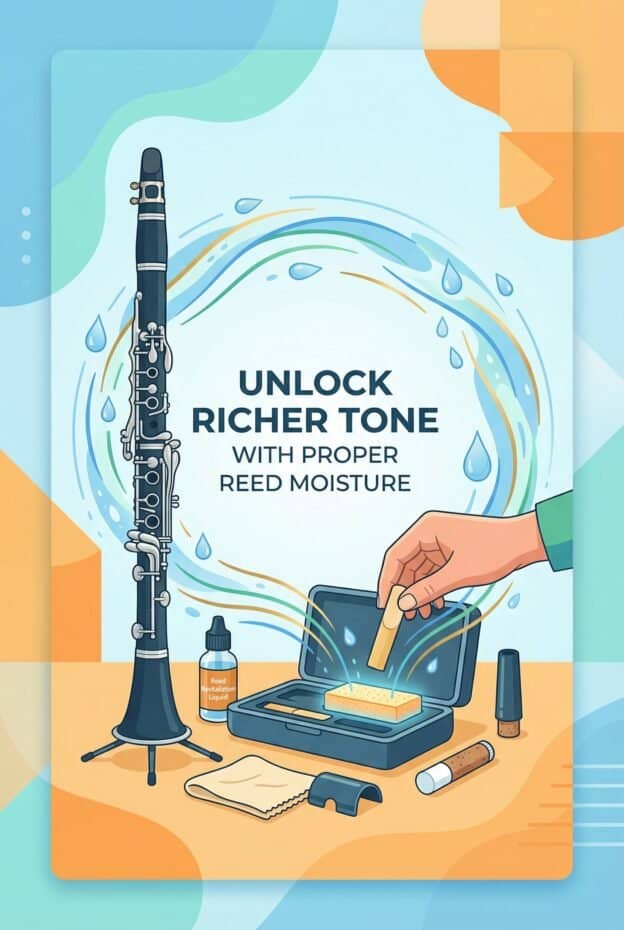Quick reed-moistening methods: Lip technique: hold the reed between your lips for about 30 seconds, rotating slightly. Soak: immerse the reed tip-first in room-temperature water for 30 to 60 seconds. Mist: spray a light coat of distilled water on both faces. For ongoing readiness, store reeds in a humidity-controlled reed holder.
Why Moisture Matters for Clarinet Reeds
Clarinet reeds respond to moisture more than almost any other part of the instrument. The right amount of moisture lets the reed vibrate freely, which gives you a full tone, stable pitch, and clean articulation. Too dry or too wet, and the reed will feel unpredictable, squeak more, and wear out faster.
Natural cane is a plant material with tiny tubes that absorb and release water. When a reed is properly moistened, the cane softens just enough to respond easily to air and embouchure pressure. When it dries, it stiffens, warps, and can develop microscopic cracks that shorten its useful life and change its response.
Moisture also affects how evenly the reed vibrates from side to side. Uneven moisture can make one side softer than the other, which leads to a buzzy or unbalanced sound. Consistent moisture control helps the reed break in gradually and stay stable from rehearsal to rehearsal.
For students, amateurs, and professionals, a clear moisture routine saves time and frustration. Instead of guessing whether a reed is ready, you can follow predictable steps, get repeatable results, and spend your practice time making music rather than fighting the equipment.
Types of Reeds and How They React to Moisture
Clarinet reeds fall into two broad categories: natural cane and synthetic. Cane reeds are made from Arundo donax, a giant grass used for reeds since the 19th century. Synthetic reeds, such as Legere and others, use plastics or composite materials that absorb very little water and react differently to moisture.
Cane reeds soak up moisture into the outer layers of the cane. As they absorb water, they become more flexible and responsive, but also more fragile. If they absorb too much, the fibers swell, the tip can feel mushy, and the reed may close off or feel unstable at louder dynamics.
Synthetic reeds do not need traditional soaking. They do not swell or shrink with humidity in the same way, so they stay more consistent from day to day. A quick rinse or light mist is usually enough to remove dust and slightly lubricate the surface without changing strength or response.
Historically, clarinetists only had cane reeds, and players in orchestras and bands had to learn careful moisture control to keep reeds from cracking under dry stage lights. With modern synthetic options, some players choose a mix: cane for richness of tone, synthetic for stability in extreme climates or outdoor marching situations.
Within cane reeds, cut and thickness also influence moisture behavior. French-filed cuts may absorb a bit more evenly along the vamp, while unfiled cuts can feel slightly stiffer when first moistened. Stronger reeds (higher strength numbers) often need a bit more time to fully respond to moisture than softer reeds.
Quick Moistening Methods (Lip, Soak, Spray) with Timings
Quick moistening methods are important when you have limited prep time before rehearsal or performance. The three most common approaches are the lip technique, short water soaks, and light water sprays. Each method has specific timings that help you avoid over- or under-moistening the reed.
Lip technique: 30-second warm up
Place the flat side of the reed against your lower lip, with the tip aligned near the wettest part of the lip. Gently close your upper lip over the vamp so both faces of the reed contact moisture. Hold for about 30 seconds, rotating the reed slightly every 10 seconds to moisten both sides evenly.
This method uses saliva as a natural moisturizer. It is fast, quiet, and ideal when you cannot access water. However, saliva contains enzymes and sugars that can leave residue on the reed over time, so you should still rinse or wipe reeds regularly to keep them clean and responsive.
Short soak: 30 to 60 seconds in water
Fill a small, clean container with room-temperature distilled water. Hold the reed by the heel and dip the tip and vamp into the water, leaving the stock and heel mostly dry. Soak for 30 to 60 seconds, depending on reed strength and dryness, then remove and gently wipe excess water from the flat side with your thumb.
Thirty seconds often works for a reed that has been played recently and stored in a humid holder. Up to 60 seconds may be needed for a new or very dry reed. Avoid soaking longer than 2 minutes, since extended soaking can swell the cane, soften the tip too much, and shorten reed life.
Spray or mist: fast and controlled
Use a small spray bottle filled with distilled water. Hold the reed by the heel and lightly mist the vamp and tip from about 6 to 8 inches away. Flip the reed and mist the flat side once. Wait 30 seconds for the water to absorb, then gently blot any visible droplets with a clean cloth or paper.
Misting is ideal for players who want precise control and dislike the feel of saliva on reeds. It also reduces the risk of over-soaking, since each spray delivers a small, predictable amount of moisture. This method works well in combination with humidity-controlled reed cases for consistent day-to-day performance.
Choosing a Reed Moisturizer: Oil, Water, or Gel
Clarinet reed moisturizers fall into three broad categories: water based, oil based, and gel based. Each type affects cane differently and suits different playing environments. Choosing the right option depends on your climate, how often you play, and your tolerance for mess or maintenance.
Water-based moisturizers
Water-based moisturizers include simple distilled water, commercial reed sprays, and moisture pads that release water vapor. These products hydrate the outer cane fibers without leaving a lasting film. They are clean, easy to control, and safe for most players, including students in school band programs.
Distilled water is preferred because it contains no minerals that might deposit on the reed surface. Many players keep a small 30 to 50 milliliter spray bottle in their case. A few light sprays before playing, combined with humidity-controlled storage, usually provide enough moisture for reliable response.
Oil-based moisturizers
Oil-based moisturizers use light, food-safe oils in very small amounts to slow evaporation and keep reeds from drying out too quickly. Some clarinetists in very dry climates apply a tiny amount of oil to the vamp with a fingertip, then wipe off excess. The goal is a barely noticeable film, not a shiny surface.
Oil can make the reed feel slightly smoother and may help prevent surface cracking in extremely low humidity. However, too much oil can clog the pores of the cane, reduce vibration, and attract dust. Oil-based products require discipline and are usually better suited to experienced players who know their reeds well.
Gel-based moisturizers
Gel-based reed moisturizers are often built into reed cases or small containers. A hydrated gel pad releases moisture slowly into a closed environment, keeping reeds at a stable humidity. You do not apply the gel directly to the reed; instead, the reed absorbs water vapor from the air inside the case.
This approach is clean, low mess, and ideal for long-term storage. It reduces cracking and warping between practice sessions and makes pre-play moistening faster. Many humidity-controlled cases use replaceable gel or sponge inserts that you rehydrate with distilled water every few weeks.
Daily Maintenance Steps and Storage Recommendations
A short, consistent daily routine keeps reeds responsive and extends their life. The goal is to control moisture before, during, and after playing. Follow the same steps whether you are a beginner in school band or a semi-professional preparing for regular performances.
Step-by-step daily routine
- Inspect the reed: Check the tip for chips, cracks, or warping. Look at the rails to be sure they are even and not lifting away from the table.
- Clean the surface: Rinse briefly in distilled water or wipe gently with a clean, damp cloth to remove dried saliva and residue.
- Moisten the reed: Use lip, soak, or spray method. For most players, 30 seconds with lips or 30 to 60 seconds in water is enough.
- Seat the reed: Align the tip with the mouthpiece tip, center the rails, and tighten the ligature just enough to prevent slipping.
- Test and adjust: Play long tones and simple scales for 2 to 3 minutes to let the reed settle before demanding passages.
After-playing care
When you finish playing, rinse the reed briefly in distilled water to remove saliva and sugars. Gently wipe the flat side against a clean cloth to remove excess moisture. Avoid rubbing the tip. Place the reed flat in a reed case that supports the entire vamp to prevent warping as it dries.
Do not leave reeds on the mouthpiece in the case, and do not store them in the original plastic sleeves long term. Both habits trap uneven moisture and encourage mold or warping. Rotate several reeds in a labeled reed case so that each reed has time to rest and dry between uses.
Storage recommendations
Use a rigid reed case that holds each reed flat against a glass, acrylic, or grooved plastic surface. If possible, choose a case with a humidity-control feature, such as a gel pad or sponge. Keep the case away from direct heat, car dashboards, and bathroom sinks where temperature and humidity swing rapidly.
For players in very dry climates, aim for a storage environment around 45 to 60 percent relative humidity. In very humid regions, focus on even drying and cleanliness, and use shorter moistening times before playing. Always label reeds with the date you started using them and rotate older reeds toward lighter practice duties.
How to Recognize and Troubleshoot Moisture Problems
Many common reed problems come from moisture that is either too low, too high, or uneven. Learning to read the signs helps you fix issues quickly and decide whether to adjust moisture, change reeds, or look at other parts of your setup such as mouthpiece or embouchure.
Symptom-to-solution guide
| Symptom | Likely moisture issue | Practical solution |
|---|---|---|
| Thin, airy, or scratchy sound | Reed too dry or unevenly moistened | Soak in room-temperature water for 30 to 60 seconds or use 3 to 4 light sprays of distilled water. Play long tones to let moisture distribute. |
| Fuzzy, unfocused tone | Reed slightly too wet | Gently blot the flat side on a cloth and let the reed air dry for 1 to 2 minutes before playing again. |
| Frequent squeaks right after moistening | Reed over-saturated or too soft | Allow the reed to rest and dry for several minutes. Check ligature tightness and embouchure firmness. Reduce soaking time next session. |
| Reed feels heavy and unresponsive | Waterlogged or old reed | Shorten soaking time, store in a humidity-controlled case, or retire the reed if fibers feel spongy and slow. |
| Warped reed that will not seal | Uneven drying between uses | Switch to a flat-surface reed case with humidity control. Lightly flatten on glass if you have experience, or replace the reed. |
Not every problem is moisture related. Mouthpiece facing, embouchure strength, and air support also affect tone and response. If several reeds behave the same way, check your equipment and playing habits before blaming moisture alone.
Synthetic reeds behave differently. If a synthetic reed sounds thin or bright, moisture is rarely the cause; instead, try a different strength or model. A quick rinse in lukewarm water is usually enough to restore a synthetic reed that feels dusty or slightly sluggish.
When to Use Humidity-Controlled Reed Holders and Cases
Humidity-controlled reed holders and cases are valuable tools for players who want consistent reeds across different environments. These cases use gel pads, sponges, or humidity packs to keep the air around the reeds at a stable moisture level, which reduces warping and cracking between sessions.
Consider a humidity-controlled case if you live in a very dry climate, rehearse in air-conditioned rooms, or frequently travel between locations with different humidity. In these situations, reeds stored in open air can dry out too much, leading to brittle tips and unpredictable response the next time you play.
These cases are also useful for students who forget to rotate reeds or who leave reeds on the mouthpiece. A good case encourages better habits and protects reeds from physical damage in crowded band lockers or backpacks.
When using a humidity-controlled case, follow the manufacturer's instructions for hydrating the gel or sponge. Use distilled water, avoid overfilling, and check the insert every few weeks. If the case feels damp or smells musty, let it air out and clean it before placing reeds back inside.
Even with humidity control, you still need a brief pre-play moistening routine. The case keeps reeds closer to playing condition, so 15 to 30 seconds of lip moistening or a light mist is usually enough, instead of a full 60-second soak.
Practical Routine: Pre-Performance Checklist
A clear pre-performance checklist helps you manage moisture under pressure. Use this routine before concerts, auditions, and important rehearsals so you know each reed is ready. Adjust timings slightly based on your climate and personal preference, but keep the order consistent.
Pre-performance moisture checklist
- Select 2 to 4 reeds: Choose reeds from your rotation that have played well in the last week. Inspect tips and rails for damage.
- Clean and rinse: Quickly rinse each reed in distilled water or wipe with a damp cloth to remove old residue.
- Moisten primary reed: Use your preferred method: 30 seconds with lips, 30 to 60 seconds soak, or 2 to 3 light sprays. Let the reed rest for 1 minute.
- Moisten backup reeds: Prepare at least one backup reed using the same method so it is ready if you need to switch mid-performance.
- Seat and test: Place the primary reed on the mouthpiece, align carefully, and tighten the ligature. Play long tones, scales, and a few excerpts to confirm response.
- Fine-tune moisture: If the reed feels dry, give it a brief additional mist or 10-second lip moistening. If too wet, blot lightly and let it rest for 1 to 2 minutes.
- Stage-ready storage: Keep backup reeds in a humidity-controlled case near the stage, not in a hot or cold dressing room, so they stay stable during the performance.
With practice, this checklist takes only 5 to 10 minutes and greatly reduces surprises on stage. You will know that any problems you encounter are musical or technical, not the result of a neglected reed.
Key Takeaways
- Clarinet reeds play best with controlled, moderate moisture. Aim for 30 to 60 seconds of moistening using lips, soaking, or misting before serious playing.
- Water-based methods and humidity-controlled cases are clean, predictable ways to keep cane reeds stable, reduce warping, and extend reed life.
- Recognize moisture symptoms early: thin and scratchy often means too dry, fuzzy and unfocused often means too wet. Adjust soaking time and storage accordingly.
- A simple daily routine and pre-performance checklist give you consistent response, richer tone, and fewer squeaks, so you can focus on music instead of equipment.
FAQ
What is clarinet reed moisturizer?
Clarinet reed moisturizer is any product or method used to control the moisture level of a reed so it vibrates reliably. It can be as simple as distilled water for soaking or spraying, or more specialized tools like humidity-controlled reed cases and gel pads that keep reeds at a stable humidity between playing sessions.
How long should I soak a clarinet reed?
Most cane clarinet reeds only need 30 to 60 seconds in room-temperature water. New or very dry reeds may benefit from the full 60 seconds, while reeds stored in a humidity-controlled case often need only 30 seconds or a light mist. Avoid soaking longer than 2 minutes to prevent swelling and shortened reed life.
Can I use lip moisture to prepare a reed before playing?
Yes, many players use lip moisture as a quick and effective way to prepare reeds. Holding the reed between your lips for about 30 seconds usually provides enough moisture for warm-up and light playing. For longer or more demanding sessions, combine lip moistening with a brief water soak or mist for more even hydration.
Which is better for reeds: oil-based or water-based moisturizers?
For most clarinetists, water-based moisturizers such as distilled water or commercial reed sprays are safer and easier to control. Oil-based products can help in very dry climates but must be used sparingly, since excess oil can clog cane fibers and attract dust. Beginners and students should start with water-based methods and humidity-controlled storage.
How do I tell if a reed is too wet or too dry?
A reed that is too dry often sounds thin, airy, or scratchy and may feel stiff or resistant. A reed that is too wet usually feels heavy, responds slowly, and produces a fuzzy or unfocused tone, sometimes with sudden squeaks right after soaking. Adjust your moistening time and blotting until the reed feels responsive without being mushy.







